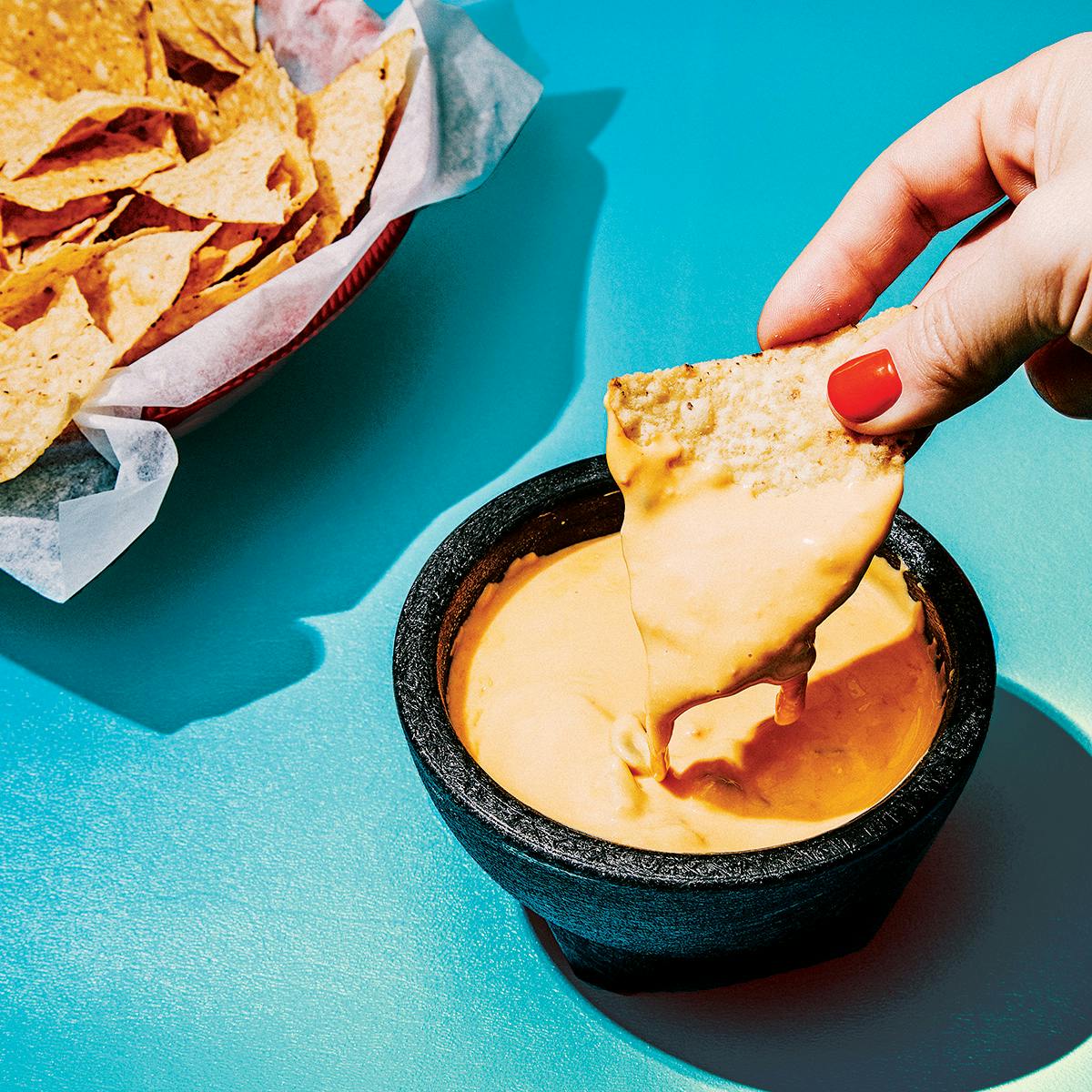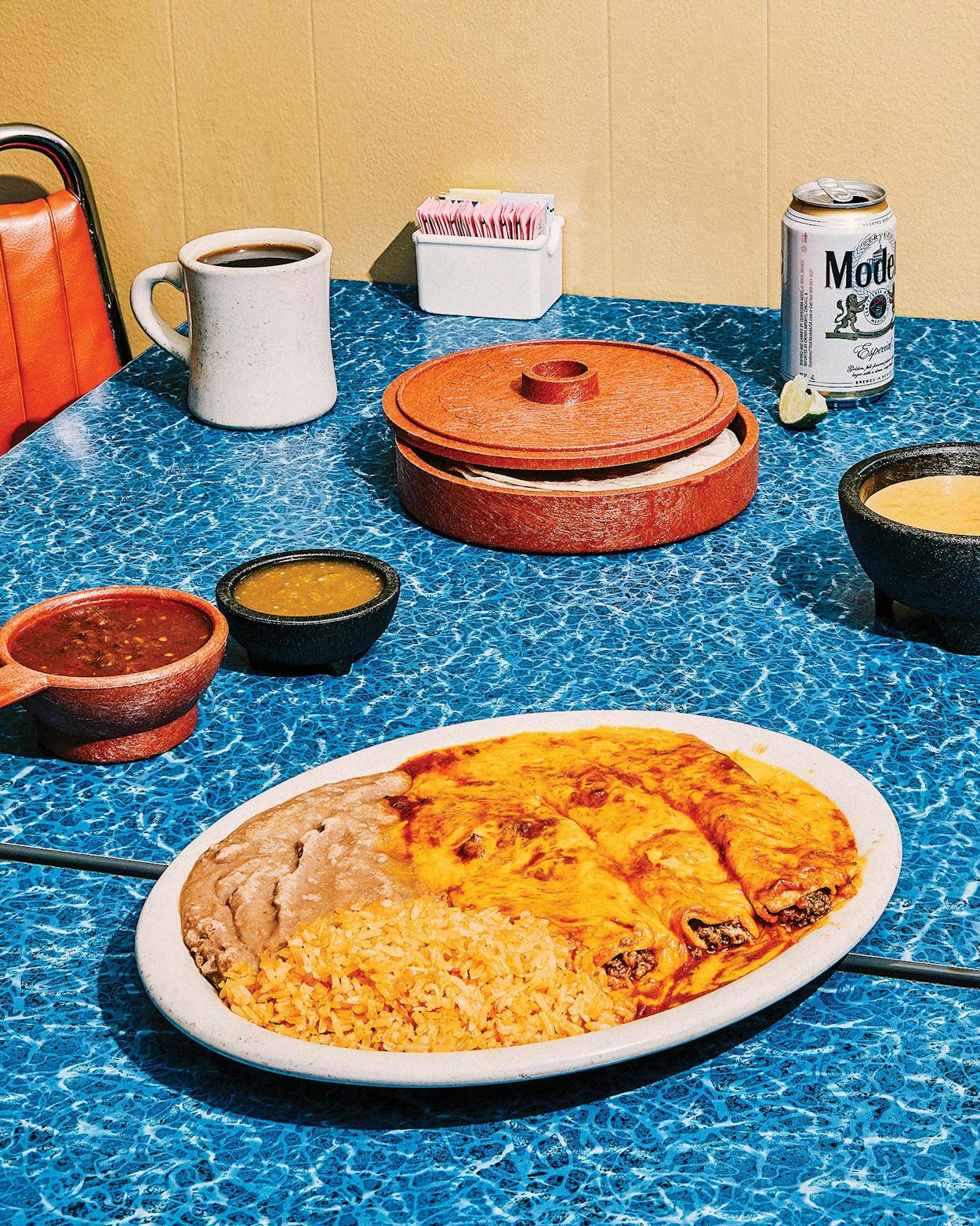I’M WRITING THIS COLUMN TO apologize for having laughed at my friend and colleague Sam Gwynne. (I was laughing with you, Sam. Honest.) A recovering Yankee, Sam has made enormous progress in understanding the behavior and tribal customs of Texans during the nine years he’s lived here. But there is one thing he just can’t seem to get a handle on: As he put it recently, “What the hell is the difference between Mexican food and Tex-Mex?” Sam has been tragically misinformed that all sorts of popular dishes are Tex-Mex—quesadillas, breakfast tacos, charro beans, black beans, tomatillo sauce, flan, and sopaipillas, to name a few. His questions always make my day, but the afternoon he appeared at my office door to ask plaintively, “Are jalapeños Tex-Mex?” I knew he needed serious help. So, for Sam and everybody else who didn’t have the good fortune to get here before 1970, here’s my short course on the cuisine that was fusion before fusion was hip.
Austin, circa 1955: I’m with my two best friends from junior high school, Laura Ellen and Mary Jean. As they regularly do, Laura Ellen’s parents, Mr. and Mrs. Glass, have taken us out to eat Mexican food at El Toro (where the Clay Pit restaurant is now), a big, bustling space filled with tables and vinyl booths and with a large bullfight painting on one wall. While scanning the menu (which we have all but memorized), we pass the time eating saltines, supplied in cellophane wrappers, and hot corn tortillas, which we butter, salt, and roll up like cigars. There are no chips. Mr. Glass spoons a little of the thin, tomatoey hot sauce onto his crackers. Like the waiters, the restaurant’s owner, Monroe Lopez, is of Mexican descent. Most of the customers wolfing down rolled-up tortillas are Anglo. The dining room could be the supporting cast for The Adventures of Ozzie and Harriet.
Mr. and Mrs. Glass each get a beer (margaritas had not made the scene yet). Then they order combination plates: yellow-cheese-and-onion enchiladas, pork tamales, an ocean of ground-beef chile con carne (seasoned with red chile, garlic, and lots of cumin), refried beans, and Spanish rice. Laura Ellen has crispy tacos filled with hamburger meat (seasoned with garlic and a little chile) and topped with rapidly warming lettuce and chopped tomato. Mary Jean gets puffy tacos filled with the same thing. (Definitions are in order here: A crispy taco was—is—made with a hard-fried, folded-over corn tortilla; a puffy taco is a corn tortilla that has been fried so that its layers delicately separate and balloon out.) I get chalupas compuestas, two crisp-fried flat corn tortillas topped with refried beans, melted yellow cheese, lettuce, and tomato. My friends and I are so filled with anticipation we can hardly sit still.
Our harried waiter warns, “Hotplatehotplate!”—spoken as a single word—as he slides the platters onto the table and checks to see that our tortilla basket is full. Twenty minutes of contented munching ensues. At the end of the meal, he reappears to leave the check and inquire, “Sherbetorcandy?” Did we want a dish of sherbet (pineapple, lime, or orange) or a crisp (not chewy) pecan praline for dessert? That was pretty much what we ate every time. There were no chicken enchiladas in chipotle sauce, no flautas with guacamole and sour cream, no tacos al carbón. None of the dishes that are now so common would become mainstream in Mexican restaurants here for at least another fifteen years. But in case you’re feeling sorry for us, don’t. At home, we were all eating tuna casserole, lime Jell-O, and frozen TV dinners. We would have sooner skipped church than our weekly Mexican food fix.
What I like to call classic Tex-Mex was born in Texas in the Mexican restaurants run by first- and second-generation immigrants during the first third of the twentieth century. It peaked in a kind of golden age (the color of melted Velveeta, no doubt) that lasted roughly from World War II to the Vietnam War. During this two- to three-decade span, the spicy components of the combination plate became our most treasured, and most Texan, comfort food. Going out for enchiladas and tacos was a cultural ritual that bound us together as surely as gathering for turkey, dressing, and pumpkin pie at Thanksgiving. By the seventies, though, the winds of change were blowing, and as streams of new Mexican immigrants moved north, bringing with them their more varied and, yes, more exciting interior styles of cooking, classic Tex-Mex began a slow, inexorable fade into the background.

What put the Tex in Tex-Mex? Three things: American yellow cheese, chile con carne, and the infinite malleability of the corn tortilla. (Rice and refried beans, while essential, were basically the same rice and beans served in Mexico.) First and foremost, though, is cheese. In Texas during the heyday of Tex-Mex, if it wasn’t yellow, it wasn’t cheese. Oh, all right—if you looked hard, you could find a few other cheeses, but they lagged far behind yellow cheese in popularity. Knowing what their customers liked, and being no fools, Mexican restaurateurs went with the flow. Most of them used mild American cheese for filling and topping enchiladas; some preferred real cheddar. (Kraft’s Velveeta, being utterly bland and easy to melt, was ideal for creating the thin, seasoned sauce called chile con queso. So beloved was queso that it took on a life of its own as the national party dip of Texas.) Maybe one in a hundred restaurants used Monterey jack. But even if there had been more-expensive imported Mexican cheeses around, few would have bought them because part of the appeal of Mexican food was that it was cheap. It would have been economic suicide to buck the trend.
The second major component of Tex-Mex is chile con carne, a.k.a. chili. The familiar spicy ground-beef stew that we all know and love, or at least tolerate, chili was already a staple in Texas well before the Great Depression of the thirties, when a poor person could buy a filling bowl of it with crackers for a nickel or a dime. Since many Mexican restaurants initially served American dishes too, chili was often already on the menu. Ladling some on a plate of enchiladas wasn’t even a stretch, and enchiladas and tamales sauced with chile con carne had practically become a basic food group by the fifties. Some restaurant owners objected that the combination wasn’t “Mexican,” and they were right. It was Texan.
Ah, the tortilla—master of, well, a dozen disguises. Tortillas go back at least to the Maya and the Aztecs, but it took the cagey Mexican-food entrepreneurs of the twentieth century and their deep-fat fryers to fully exploit the tortilla’s possibilities. The crispy taco and the now charmingly archaic puffy taco both emerged from this felicitous union, but the two most important, and most Texan, variations on the tortilla were the tortilla chip and, in turn, its apotheosis, the nacho. It is a fact that until recently, restaurants in Mexico did not serve either tostadas or nachos as appetizers, nor did the earliest Mexican restaurants in Texas. These snacks didn’t materialize until sometime around World War II. If you know a grad student who needs a dissertation topic, tell her or him to figure out which of the several cafes along the border that claim to have invented the nacho was actually the first to do it. That would be a worthy contribution to human knowledge.
One quick final aside. I haven’t forgotten the state’s most ubiquitous Tex-Mex dish: fajitas. It’s quite true that the fajita plate, with its dramatic sizzle and forest of condiments, was cooked up in Texas. But fajitas did not become outrageously popular until 1973—when Ninfa’s opened in Houston and began selling tacos al carbón—and that was after the classic Tex-Mex era.
Up until thirty years ago, Tex-Mex was the big enchilada at every Mexican restaurant in the state (sorry, couldn’t resist). Our universe back then was so Tex-centric that people would return from their first trip to Monterrey or Saltillo griping that they couldn’t get any Mexican food there. It wasn’t until travel and the arrival of new immigrants broadened our worldview that we realized that what we had here wasn’t interior Mexican food but a distinctive regional cuisine that deserved its own name. Luckily, one was easily appropriated—the catchy term already in use for the border patois that today we call Spanglish. Today Tex-Mex has been downsized to a puffy taco, but most Mexican restaurants serve at least a few dishes. (Some of the most venerable purveyors are Dallas’s El Fenix, founded in 1918; Fort Worth’s Joe T. Garcia’s, 1935; San Antonio’s Mi Tierra, 1941; Houston’s Molina’s, 1941; and Austin’s El Rancho, 1952.) Just scan the menu for words like “Combinaciones Mexicanas” or “Classic Texas Enchiladas.” If you’re of a certain age, order a Señorita Special for old times’ sake. If you’re a newcomer, have one out of curiosity. You’ll be eating a part of Texas history.
And, Sam, jalapeños are Tex-Mex only if they’re stuffed with Velveeta.









